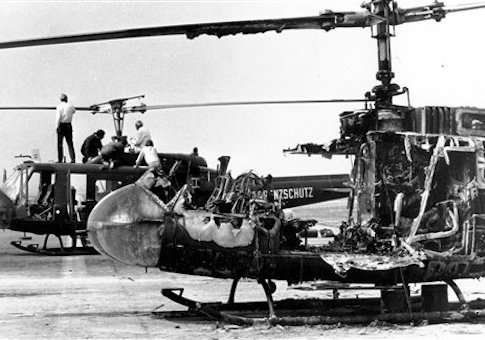JERUSALEM—It was the most brazen terror attack Europe had seen since the Second World War—eight Palestinian gunmen slipping at night into the Israeli athletes’ pavilion at the Munich Olympics, shooting two wrestlers who tried to block their way, and taking nine other athletes hostage.
In what was ostensibly the first stage of a prisoner exchange involving more than 200 prisoners held by Israel, the Israelis and their captors were helicoptered by German police to a nearby military airfield where they were to board a waiting Lufthansa plane.
However, German security forces were waiting in ambush at the airfield that night, 42 years ago this weekend. Watching the unfolding drama on television, the world soon learned that the awesome prowess that armed Germans had demonstrated in past wars no longer had relevance. In a police operation botched from start to finish, all the Israeli hostages were killed by their captors with grenades and gunfire as they sat bound in two helicopters. Five of the Palestinians and a German policeman were also killed. The three Palestinians who were captured would be released a few days later after other Palestinians hijacked a Lufthansa plane.
In Jerusalem, there was grim determination for vengeance. However, there was also a larger motivation—to create deterrence that would be strong enough to make Israel’s enemies hesitate to undertake similar operations in the future. "We must change them (the Palestinians) from hunters to prey," as one minister put it.
Prime Minister Golda Meir summoned the head of the Mossad, Zvi Zamir, and ordered him undertake a gloves-off campaign against leaders and operatives of Black September, the Palestinian organization behind the Munich massacre. The Mossad had on occasion engaged in individual assassinations but this was now to become a major tool that would ignore national sovereignties in the organization’s relentless hunt.
Sometimes a victim would be gunned down in a European street or Arab capital. Most attacks, however, involved more elaborate operations. A Palestinian official in Paris, Dr. Mahmoud Hamshari, whom Israel said was a senior figure in Black September, agreed one day to be interviewed in a cafe near his home by an Italian "journalist" who was in fact an Israeli agent. During the interview, two explosives experts entered the empty apartment and planted explosives in Hamshari’s telephone. The next morning, after the agents saw his wife take their child to school, the phone rang. When Hamshari identified himself, the bomb was detonated by remote control. Other victims were killed by bombs placed under beds or car seats.
The most spectacular operation came in April 1973 when an Israeli commando force landed in rubber boats on a dark beach in Beirut. Waiting for them were vehicles brought by Mossad agents who had been in the city for a week to reconnoiter and provide logistics support. The main force was led by Ehud Barak, a future Israeli prime minister, who was dressed as a woman to diminish suspicion as they approached their target, an upscale apartment building. Three Palestinians, identified as senior Black September officials, were killed by the raiders who also made off with important documents.
Dozens of Palestinians identified by Israel as Black September activists were said to have been killed in the campaign, which reportedly extended over 20 years.
After Munich, many countries reorganized their security forces to deal with the terror threat. Foremost among these was Germany. New weaponry and tactics were devised. As for Israel, it no longer rested the security of its foreign missions or delegations on host countries but made its own provisions.
The international community as a whole would organize itself to cope with terrorist threats on a global scale. Israel was for long the only nation to wage a methodical anti-terrorist campaign abroad involving assassinations, for which it would come under periodic condemnation. In the wake of 9/11, however, the United States organized a major campaign of its own based on drone strikes in Pakistan, Yemen, and elsewhere—an intelligence and technological leap forward in the ongoing cycle of inter-war skirmishes.
